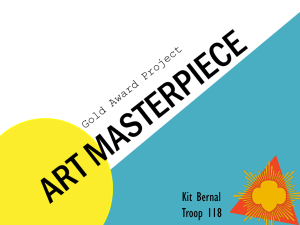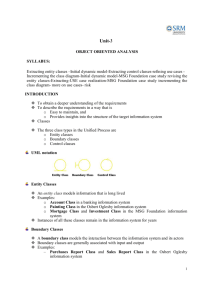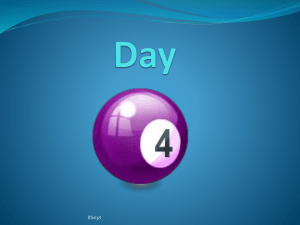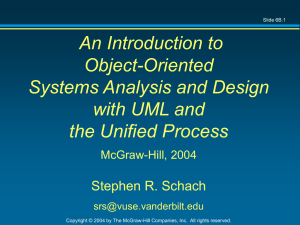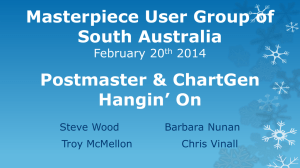09_UseCasetoImplement
advertisement
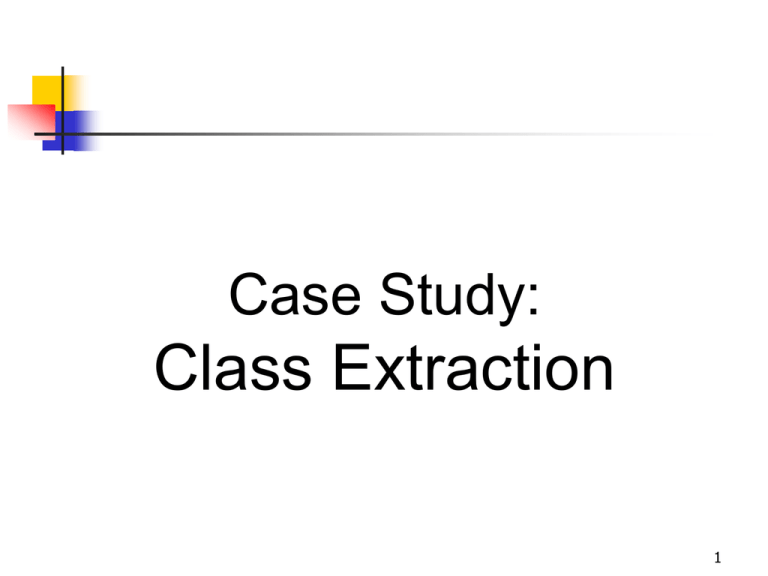
Case Study: Class Extraction 1 The Osbert Oglesby Case Study To get Initial Class Diagram : The aim of entity modeling step is to : extract entity classes, determine their interrelationships, and find their attributes Simple (yet good) way to begin this step is to use the two-stage noun extraction method 2 Noun Extraction: Osbert Oglesby Case Study Stage 1: Describe product in one paragraph: Reports are to be generated in order to improve the effectiveness of the decision-making process for buying works of art. The reports contain buying and selling information about paintings, which are classified as masterpieces, masterworks, and other paintings 3 Noun Extraction: Osbert Oglesby Stage 2: Identify nouns in this paragraph : Reports are to be generated in order to improve the effectiveness of the decision-making process for buying works of art. The reports contain buying and selling information about paintings, which are classified as masterpieces, masterworks, and other paintings 4 Noun Extraction: Osbert Oglesby The nouns are : report, effectiveness, process, buying, work of art, selling, information, painting, masterpiece, masterwork Next let’s remove some candidates : effectiveness, process and information are abstract nouns and are therefore unlikely to be entity classes Nouns buying and selling are derived from the verbs “buy” and “sell”; so probably will be operations of some class 5 Noun Extraction: Osbert Oglesby (contd) The nouns are : Report , effectiveness, process, buying, work of art, selling, information, painting, masterpiece, masterwork Noun report is more likely to be a boundary class than an entity class Noun work of art is just a synonym for This leaves four candidate entity classes: painting; so remove one of them. Painting Class, Masterpiece Class, Masterwork Class, and Other Painting Class 6 Second Iteration of Initial Class Diagram Consider interrelationships between entity classes A masterpiece is a specific type of painting, and so is a masterwork and an “other painting” : Painting Class is therefore the base class Masterpiece Class, Masterwork Class, and Other Painting Class are subclasses of that base class 8 Second Iteration of Initial Class Diagram Figure 12.18 9 Third Iteration of Initial Class Diagram Class diagram may not reflect aspects of pricing algorithm well ? When dealing with a masterwork : “The software product first computes the maximum purchase price as if it were a masterpiece by the same artist” Conclude : masterwork should have all attributes of a masterpiece (so that its maximum purchase price can be computed as if it were a masterpiece) and, in addition, it may have attributes of its own. 10 Third Iteration of the Initial Class Diagram (contd) Figure 12.19 11 Fourth Iteration of Initial Class Diagram Another aspect of pricing algorithm not reflected in the current class diagram : “The software product computes the coefficient of similarity between each painting for which there is an auction record and the painting under consideration for purchase” What if anything should we change ? 12 Fourth Iteration of Initial Class Diagram Need Auctioned Painting Class to make these comparisons Maybe, an auctioned painting must be a subclass of Painting Class ? But a painting previously been sold at an auction somewhere else has nothing to do with paintings currently on display for sale in Osbert’s gallery 13 Fourth Iteration of Initial Class Diagram Figure 12.20 14 Fourth Iteration of Initial Class Diagram So now we have that an instance of Painting Class is either : A painting that Osbert has bought (an instance of Gallery Painting Class), or A painting sold at some auction (an instance of Auctioned Painting Class) 15 Fifth Iteration of Initial Class Diagram Third aspect of maximum price algorithm not yet modeled is fashionability : “compute maximum purchase price from formula F A , where F is a constant for that artist (fashionability coefficient) …” Fashionability or Artist Class is needed : For a painting of Other Painting Class, we then can then use the artist instance of Fashionability Class to compute maximum price that Osbert should offer to pay 16 Fifth Iteration of Initial Class Diagram 17 Initial Class Diagrams ? Why was the first iteration of class diagram so inadequate? One-paragraph description correctly did not incorporate the pricing algorithm But algorithmic details turned out to affect class diagram Repeated iteration and incrementation will lead to a reasonable class diagram 18 Initial Class Diagram Next, let’s add attributes to the class diagram Later, we’ll be extending classes with operations of that class 19 Fifth Iteration of Initial Class Diagram Osbert Application Class will contain operation that starts execution of whole software product Figure 12.22 20 The Initial Dynamic Model: The Osbert Oglesby Case Study Dynamic modeling is third step in extracting entity classes A statechart is constructed that reflects all operations performed by or to the software product The operations are determined from the scenarios 21 The Initial Dynamic Model: The Osbert Oglesby Case Study Initial statechart 22 The Initial Dynamic Model: The Osbert Oglesby Case Study In state Osbert Oglesby Event Loop, one of five events can occur: buy painting selected sell painting selected print report selected update fashionability selected quit selected 24 Initial Main Menu: Osbert Oglesby Graphical user interface (GUI) “Point and click” Figure 12.25 25 26 Dynamic Modeling In object-oriented paradigm, there is a dynamic model for each class, rather than for the system as a whole : However, objects in this product never move from one class to another class Accordingly, a dynamic model for software product as a whole is appropriate 27 Extracting the Boundary Classes: The Osbert Oglesby Case Study It is easy to extract boundary classes Each input screen, output screen, and printed report is generally modeled by a boundary class One screen should be adequate for all four use cases Thus one initial boundary class User Interface Class 28 Initial Boundary Classes There are three reports: Content of each report is different The purchases report The sales report The future trends report Each report modeled by separate boundary class So four initial boundary classes : 30 Extracting Control Classes: Osbert Oglesby Case Study Extract control classes In case study, there are four computations : Each nontrivial computation modeled by a control class Determine Determine Determine Determine maximum price for Masterpiece maximum price for Masterwork maximum price for Painting if there is a new trend in art purchases There are therefore four initial control classes 31 33 Refining the Use Cases Refine our use cases based on class extraction as well as analysis of problem thus far 34 Refining the Use Cases: Osbert Oglesby Pricing algorithm treats three types of paintings differently Use case Buy a Painting therefore refined into three separate use cases : Buy a Masterpiece Buy a Masterwork Buy Other Painting 35 Refining the Use Cases: Osbert Oglesby Use case Produce a Report also needs to be refined Purchases and sales report both use simple data extraction Future trends report involves computation All three reports use their own boundary classes Thus Produce a Report use case refined into three use cases : Produce a Purchases Report Produce a Sales Report Produce a Future Trends Report 36 Third Iteration of Use-Case Diagram 37 Refining the Use Cases: Osbert Oglesby Implications for remaining UML diagrams : Buy a Painting use case must be split into three separate descriptions Produce a Report use case must be split into three separate descriptions 38 Use Case Buy a Masterpiece 39 Description of Use Case Buy a Masterpiece 40 Use-Case Realization The process of extending and refining use cases is called use-case realization That is, we aim to flesh them out in more detail and to make them “real” 41 Use-Case Realization The realization of a specific scenario of a use case is depicted using some interaction diagram : either a sequence diagram or a collaboration diagram 42 Use-Case Realization Consider use case Buy a Masterpiece Thus far, we have only English description of use cases Now, let’s make it concrete. First, consider what classes involved in use case 43 Buy a Masterpiece Use Case Class diagram (classes that enter into use case) 44 Four Classes Germane to the Use Case User Interface Class Compute Masterpiece Price Class models computation of price Osbert should offer Masterpiece Class models user interface The computation involves comparing the masterpiece being considered with masterpieces that have been previously auctioned Auctioned Painting Class These masterpieces are all instances of Auctioned Painting Class 45 Buy a Masterpiece Use Case Seller does not interact directly with software Instead, Seller provides data that Osbert enters into the software product This is indicated in the note (rectangle with top right-hand corner turned over) 46 Buy a Masterpiece Use Case Scenario (one possible instance of the use case) 47 Buy a Masterpiece Use Case An executing software product uses objects, not classes Example: A specific masterpiece is not represented by Masterpiece Class but rather by an object, a specific instance of Masterpiece Class Such an object is denoted in UML by : Masterpiece Class 48 Buy a Masterpiece Use Case A class diagram shows the classes in the use case and their relationships It does not show the objects Nor the sequence of messages as they are sent from object to object Something more is needed .. . 49 Collaboration Diagram: Buy a Masterpiece A collaboration diagram (of the realization of the scenario of the use case) 50 Buy a Masterpiece Use Case Osbert will not approve the specification document unless he understands it Accordingly, a written description of the collaboration diagram is needed The flow of events 51 Buy a Masterpiece Use Case Express in words the flow of events of the collaboration diagram (of the realization of scenario of the use case ) 52 2 Types of Interaction Diagrams UML supports two different types of interaction diagrams : Collaboration diagram Sequence diagram Both contain the same information (events passed among objects or sequences over time), but displayed in different ways 53 Buy a Masterpiece Use Case Sequence diagram equivalent to collaboration diagram 54 Notice: Buy a Masterpiece Use Case Sequence diagram shows that every message of scenario involves either : instance of user interface class : User Interface Class or instance of control class : Compute Masterpiece Price Class Every transfer of information from object A to object B is eventually followed by a transfer in the reverse direction 56 2 Types of Interaction Diagrams Software engineers (you) can choose whether to use : A sequence diagram, or A collaboration diagram, or Both for each scenario 57 Interaction Diagrams : pros and cons ? Sequence versus collaboration diagram ? sequence diagram : shows flow of messages and their order unambiguously Superior when transfer of information is focus of attention collaboration diagram : similar to a class diagram more useful when developers concentrate on classes 58 Buy a Masterpiece Use Case The seven previous figures depict different aspects of the use case Buy a Masterpiece : They use different notations Provide different levels of detail of same activity Why do we construct so many related artifacts? We examine this one activity from a variety of different perspectives to learn enough about it to ensure that the analysis workflow will be correct 59 Summary : Refining Use Cases Refine use cases using interaction diagrams From the abstract to the implementable 60

